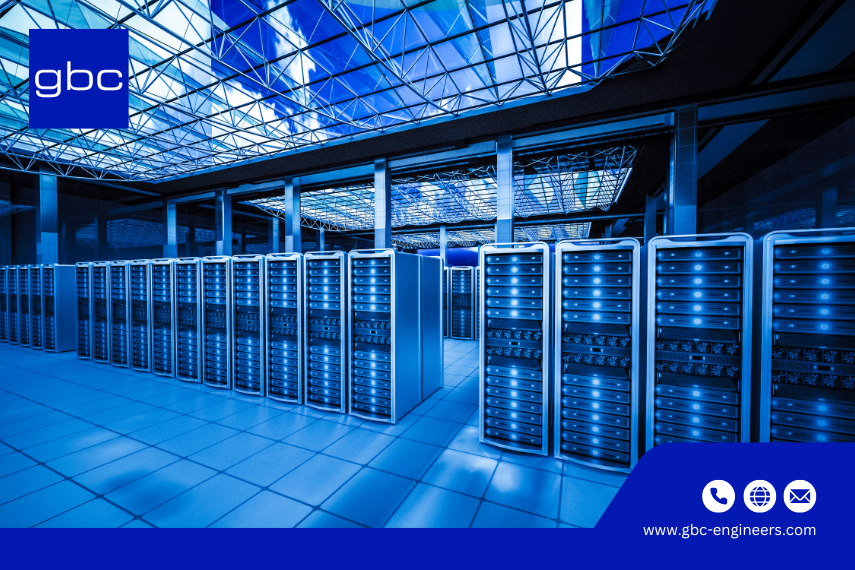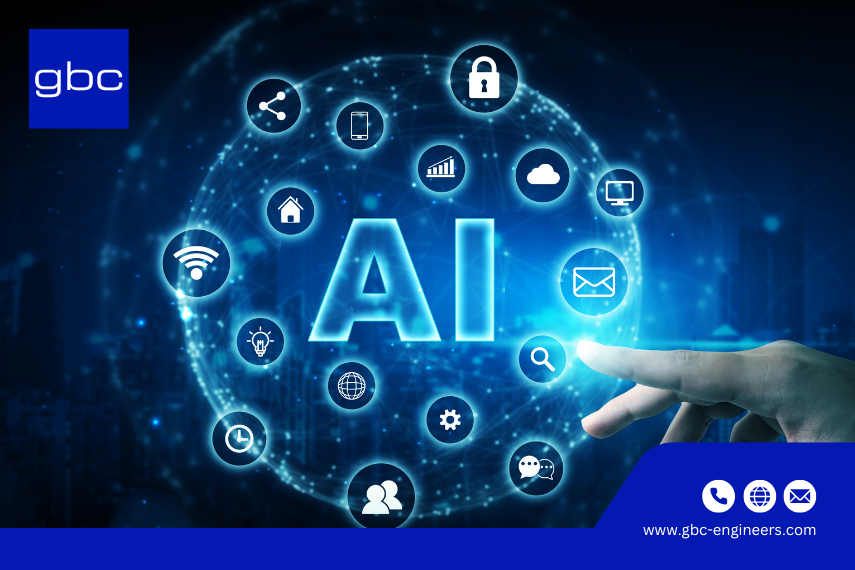In an era defined by digital transformation and exponential data growth, AI data centers have emerged as a revolutionary force reshaping the landscape of information technology. As artificial intelligence continues to permeate every industry, data centers are evolving from passive storage facilities into intelligent, self-optimizing ecosystems.
But what exactly is an AI data center, and how is it changing the future of infrastructure? Let’s explore how gbc engineers is navigating the rise of AI data center design: examining their impact on infrastructure, energy demand, and the future of sustainable, high-performance computing.
What Are AI Data Centers?
Most data centers rely on the municipal electric grid as their primary source of power. This grid supplies energy, which is then transformed onsite to meet the voltage and current needs of the data center's IT systems. In addition to the municipal grid, many data centers incorporate backup generators to maintain continuity during grid failures or interruptions. These generators can supplement the primary power source or act as a fail-safe in case of power loss, ensuring uninterrupted access to essential resources and services.
Power delivered to a data center undergoes several stages of transformation and distribution. Upon entering the facility, power is directed to Main Distribution Boards (MDBs), from which it is distributed to various systems like UPS units, load banks, and IT equipment. This process ensures that sensitive systems are shielded from power surges or interruptions, maintaining operational uptime and preventing potential damage to the technology that drives these high-performance facilities.
A key component in this setup is the Uninterrupted Power Supply (UPS) system. UPS systems provide a temporary power supply during disruptions, allowing enough time for backup generators to kick in and maintain smooth operations. These systems are crucial for protecting critical infrastructure, ensuring that even short power outages do not impact the data center's functionality or the companies that depend on its services. UPS units are part of the required resilience architecture that modern facilities must adopt to meet the demands of digital reliability and operational continuity.
AI’s Growing Impact on the Data Center Industry
In 2025, the data center industry reached a turning point. After attending nearly ten major conferences worldwide, one thing became clear: AI-specific requirements are driving the next wave of data center design.
Concepts like AI training, inference, liquid cooling, and high-performance computing (HPC) took center stage. Yet, many traditional operators were unprepared for the shift in infrastructure demands—from data storage to compute-centric processing. AI is bridging the gap between cloud computing and HPC, driving new terminologies and solutions across the sector.

Read More: Top 5 Data Center Technologies in 2025: Emerging & Networking - gbc engineers
A Look Back: Historical Use of AI in Data Centers
Decades ago, AI started with basic monitoring systems. As data volumes and processing needs grew, AI-powered analytics began to streamline server management and optimize infrastructure. The arrival of big data and advanced ML models enabled data centers to predict and prevent downtime, cut energy costs, and balance workloads intelligently.
Now, AI data centers have transformed into strategic digital assets—not just maintaining IT operations but guiding business decisions through real-time insights.
The Evolution of AI in Data Centers
AI in data centers is not a novel idea—it has evolved steadily from basic automation tools to complex machine learning (ML) and neural networks that can predict hardware failures before they happen, automatically reroute workloads for maximum efficiency, and optimize energy usage in real time.
This progression marks a significant shift toward self-managing and self-healing data centers that can scale with the growing demands of modern AI workloads. For any company looking to stay competitive, investing in AI-driven systems—whether through private builds or colocation services—has become essential. These advancements not only make operations more efficient but also position data centers to support the future of intelligent computing.
Understanding AI Infrastructure: The Shift from Data to Compute
One of the most critical changes in AI data centers is the shift from storage to compute power. Traditional data centers typically operate with CPU-focused racks at around 10 kW/rack. In contrast, AI workloads rely on GPUs, consuming up to 140 kW/rack or more.
This fundamental shift highlights the difference between conventional and AI-ready facilities. As NVIDIA CEO Jensen Huang famously said, we're moving into an era of "AI factories" — data centers built for training and inference at scale.
Massive Compute Requirements
Training state-of-the-art AI models is a compute-intensive process, and the scale is staggering. Meta, for instance, reportedly trained its LLaMA 3.1 model using over 48,000 NVIDIA H100 GPUs—requiring more than 4.5 petabytes of video memory and vast energy resources. These “AI factories,” as NVIDIA’s Jensen Huang calls them, resemble production lines for digital intelligence, demanding not just powerful chips but also robust cooling mechanisms, high-speed data transfer networks, and highly resilient power frameworks.
As new data constantly flows into these training environments, the ability to handle high density computing becomes critical. A single training run for a large language model can consume as much energy as several hundred homes use annually, underlining the urgent need for efficient and sustainable infrastructure to support the future of AI.
Energy and Environmental Impacts
The rise of AI data centers is not without significant environmental implications. According to the International Energy Agency (IEA), electricity demand from data centers, AI, and crypto mining could more than double by 2026. Training advanced AI models consumes enormous amounts of power, placing strain on electrical grids and raising concerns about carbon emissions.
In some cases, companies are exploring extreme solutions—Microsoft, for example, is reportedly in discussions to reopen the decommissioned Three Mile Island nuclear plant to supply consistent power for AI operations. These trends are forcing regulators and data center operators alike to reassess sustainability strategies.
Redefining Data Center Design
AI data centers differ structurally from traditional ones. While legacy facilities focused on maximizing storage and network uptime, AI data centers prioritize compute density and are engineered to support significantly higher power consumption. Power usage per rack can exceed 100 kW—five to ten times more than what is typical in standard data centers. To manage this increased demand, facilities must incorporate advanced cooling technologies, including both liquid and air cooling, as well as optimized airflow management and robust redundancy planning.
Fast interconnects between GPUs are also essential to enable distributed training across trillions of parameters. This transformation is driving the emergence of a new generation of purpose-built campuses, designed specifically to meet the performance and efficiency needs of AI-driven workloads.

The Role of Industry Leaders
Major players in the AI and cloud markets are heavily investing in AI-optimized infrastructure. Google has developed its own Tensor Processing Units (TPUs) and is expanding its supercomputing clusters. Amazon Web Services (AWS) has created custom chips like Trainium and Inferentia to reduce reliance on third-party GPUs. Microsoft is building dedicated AI campuses, while Meta’s supercomputing ambitions include training trillion-parameter models.
Meanwhile, companies like CoreWeave—specialized in GPU-based cloud infrastructure—have emerged rapidly, attracting billions in valuation and pushing into new markets. These developments reflect the industry-wide consensus that AI workloads demand a new breed of data center.
Looking Ahead
As AI technology continues to evolve, the infrastructure behind it must scale accordingly. From generative AI to autonomous systems, future applications will rely on fast, reliable, and sustainable compute power. AI data centers are now central to that mission.
The choices companies make today—about energy sources, chip architecture, and facility location—will shape not only their competitiveness but also the global carbon footprint of the digital economy. The coming years will test the industry’s ability to balance innovation with responsibility.
Read More: Servers in Data Centers: 2025 Trends & Innovations - gbc engineers
Ready to Future-Proof Your Data Center?
Partner with gbc engineers to design a facility that delivers performance, reliability, and long-term value.
🌐 Visit: www.gbc-engineers.com
🏗️ Explore Our Services: Services - gbc engineers
Conclusion: The Future of AI Data Centers
AI data centers represent the next chapter in infrastructure evolution—where intelligence, efficiency, and adaptability converge. As businesses race to integrate AI into their operations, the demand for specialized compute-ready environments will soar.
From training massive language models to real-time inference, these intelligent hubs will power the future of innovation. Whether you call them AI Factories or Compute Centers, one thing is clear: AI is redefining what it means to be a data center.
As organizations look to stay competitive in this rapidly transforming landscape, collaboration with forward-thinking partners becomes essential. gbc engineers is committed to supporting this transition by offering innovative structural solutions and deep technical expertise tailored to the unique challenges of AI-ready infrastructure.